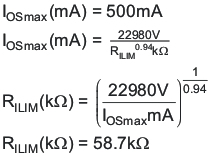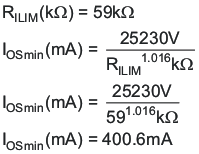SLVSBD0B November 2012 – June 2020
PRODUCTION DATA.
- 1 Features
- 2 Applications
- 3 Description
- 4 Revision History
- 5 Pin Configuration and Functions
- 6 Specifications
- 7 Parameter Measurement Information
- 8 Detailed Description
-
9 Application and Implementation
- 9.1 Application Information
- 9.2 Typical Applications
- 10Power Supply Recommendations
- 11Layout
- 12Device and Documentation Support
- 13Mechanical, Packaging, and Orderable Information
9.2.2.2 Detailed Design Procedure
For this example, assume that the desired upper current-limit threshold must be below 500 mA to protect an up-stream power supply. Use the IOS equations and Figure 22 to select RILIM.
Equation 4. 

Select the closest 1% resistor greater than the calculated value: RILIM = 59 kΩ. This sets the maximum current-limit threshold at 500 mA . Use the IOS equations, Figure 22, and the previously calculated value for RILIM to calculate the minimum resulting current-limit threshold.
Equation 5. 

The resulting minimum current-limit threshold is 400.6 mA with a 59 kΩ resistor.